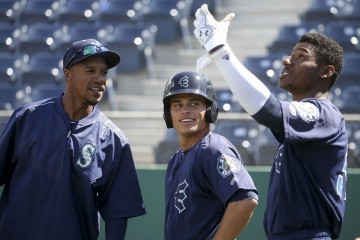The State Of The Seattle Mariners’ Farm System
Friday, January 26, 2018
BRIAN HIGHT, Oregon Sports News
 |
| Kyle Lewis |
With the major league club projected at .500, the core of the team aging (Nelson Cruz turns 38 in July – Robinson Cano is 35 – Kyle Seager is 30), and the farm system barren of major league potential talent, the future for the Mariners resembles the Seattle weather in January – bleak.
The One Top 100 Prospect
The very first draft choice made by Jerry Dipoto as the general manager of the Seattle Mariners was right handed outfielder Kyle Lewis. Lewis, chosen 11th overall in the 2016 June Amateur Draft, started 2017 as the number one prospect in the Mariners’ organization and ranked 34th overall by Baseball America (68th by Keith Law). He grades out with a slightly below average hit tool, but with good raw power, average speed, and an above average arm. The problem has been his inability to stay on the field. Hampered by a string of injuries, including the current knee issue, he played 30 games at A-, 11 games at rookie ball, and 38 games at A+. The sample sizes are too small to be taken too seriously, but his OBP and SLG have declined slightly at each subsequent level.
While Lewis remains the Mariners’ number one prospect, he has fallen to 67th on Baseball America’s list and has tumbled completely off of Law’s list. But the ups and downs of a single player isn’t an indictment of an organization as a whole, but the fact that Lewis is the only Mariner on either list is truly disturbing.
The Rest of the AL
Not every club can have top 100 prospects at any given moment. Just divide 100 by 30 clubs and you’ll see how long the odds are. In order to draft early, a club is usually very bad at the major league level. And not every top prospect translates into an everyday major leaguer, much less an impact player. But currently, the Mariners simultaneously have a depleted minor league system while watching other teams, already better than them at the major league level, stock up on prospects.
Every other team in the American League West has at least two players on Baseball America’s top 100. Not counting Shohei Ohtani at number two, who is not going to spend a lot of time, if any, in the minors, the Los Angeles Angels have the 46th and 89th prospects. The Texas Rangers chime in at 36 and 51. The Oakland Athletics have players at 30, 43, 64, and 88. And the already young and loaded Houston Astros have prospects at 10, 15, 62, and 76.
Competition across the AL is also stiff, including current contenders and up and coming teams. The New York Yankees have seven players in the top 100, including the heir apparent to Derek Jeter, Gleyber Torres, sitting at number six. The Toronto Blue Jays have Vladimir Guerrero, Jr. ranked third with four total on BA’s list. The Chicago White Sox, after selling much premium MLB talent, has five prospects in the top 100. And, last year’s surprise Minnesota Twins have four top prospects. The Tampa Rays have six. I could go on, with apologies to the Detroit Tigers, Cleveland Indians, and Boston Red Sox, who also stand out with multiple prospects.
The Mariners face a future with already good teams – Astros, Yankees, Red Sox – set to continue building and mediocre teams – Blue Jays, Rays, and White Sox – set to reload and potentially pass the Mariners.
What Does It All Mean?
The lack of organizational depth, (a lack that restless fans have started to blame on Jerry Dipoto’s trading for marginal major league talent but probably harkens back further to poor drafts and player development under the previous administration) severely hampers what the Seattle Mariners can do in-season. An impact player isn’t coming to the rescue if say the Dee Gordon experiment in center field doesn’t work out or an injury hits like it did so often last year. And, on the flip side, obtaining a major leaguer in season is unlikely with no enticing prospects to send to any potential trade partner.
With this being Nelson Cruz’s final season under contract, the Mariners need to win now. A combination of bounce back and breakout seasons will be needed at the major league level to break the longest playoff drought in major American sports. If not, the next couple of years could be devoted to yet another rebuild.

